I’m Mickey Alon, and I'm the Founder and CTO of Gainsight PX, and I'll be delving into what exactly PLG is and how you can empower product teams to deliver a complete product-led growth strategy.
This article will cover:
- What PLG is, and why it works
- PLG and the customer lifecycle - the marketing funnel vs the flywheel
- How you can use the PLG flywheel to drive customer acquisition, adoption, retention, and growth
- Key product growth tactics and KPIs you can apply
What is PLG, and why does it work?
PLG is all about using your product as the primary vehicle to drive customer acquisition, retention, and expansion.
SaaS companies are rapidly adopting PLG. Gartner predicts that 80% of IT companies will shift their structure to fit product-centered operating models by 2023.
Looking at the market data, PLG companies are able to drive much higher valuations due to a stronger unit of economics. The SaaS landscape is ultra-competitive which constantly drives higher customer acquisition costs as more and more companies enter this market.
Historically, PLG was born to optimize customer acquisition costs, though in the subscription business you have to retain customers in order to thrive. So let's understand how PLG is helping us with this.
Sustainable and durable growth
Ultimately, PLG is being adopted as it leads to sustainable and durable growth. Companies that transition to PLG both benefit from better units of economics, such as customer acquisition costs, net revenue retention, and better customer lifetime value.
So how exactly does the product becomes the PLG engine? Using free trials allows you to lower customer acquisition costs by allowing users to experience the product without being bounded to high-touch sales resources. By leading with your product, you're accelerating time to value for your customers which also means a shorter sales cycle.
Another aspect is net revenue retention. PLG is not just about a free trial or freemium; unlocking organic expansion through self-service provisioning and consumption-based pricing allows you to optimize retention. It's about building a data-driven strategy that drives value realization for your customers, which ultimately leads to stronger net revenue retention.
Some companies are born into PLG, but for others, it's a journey that goes through different stages of maturity. If you look at the graph below, companies are moving from a sales-led structure, where the product is still focusing on agility and is data-driven or experience-driven.
On the right side of the graph is product-led, where product teams are aligning behind the revenue-driven and product-led strategy, where the strategy of the product is closer to revenue.
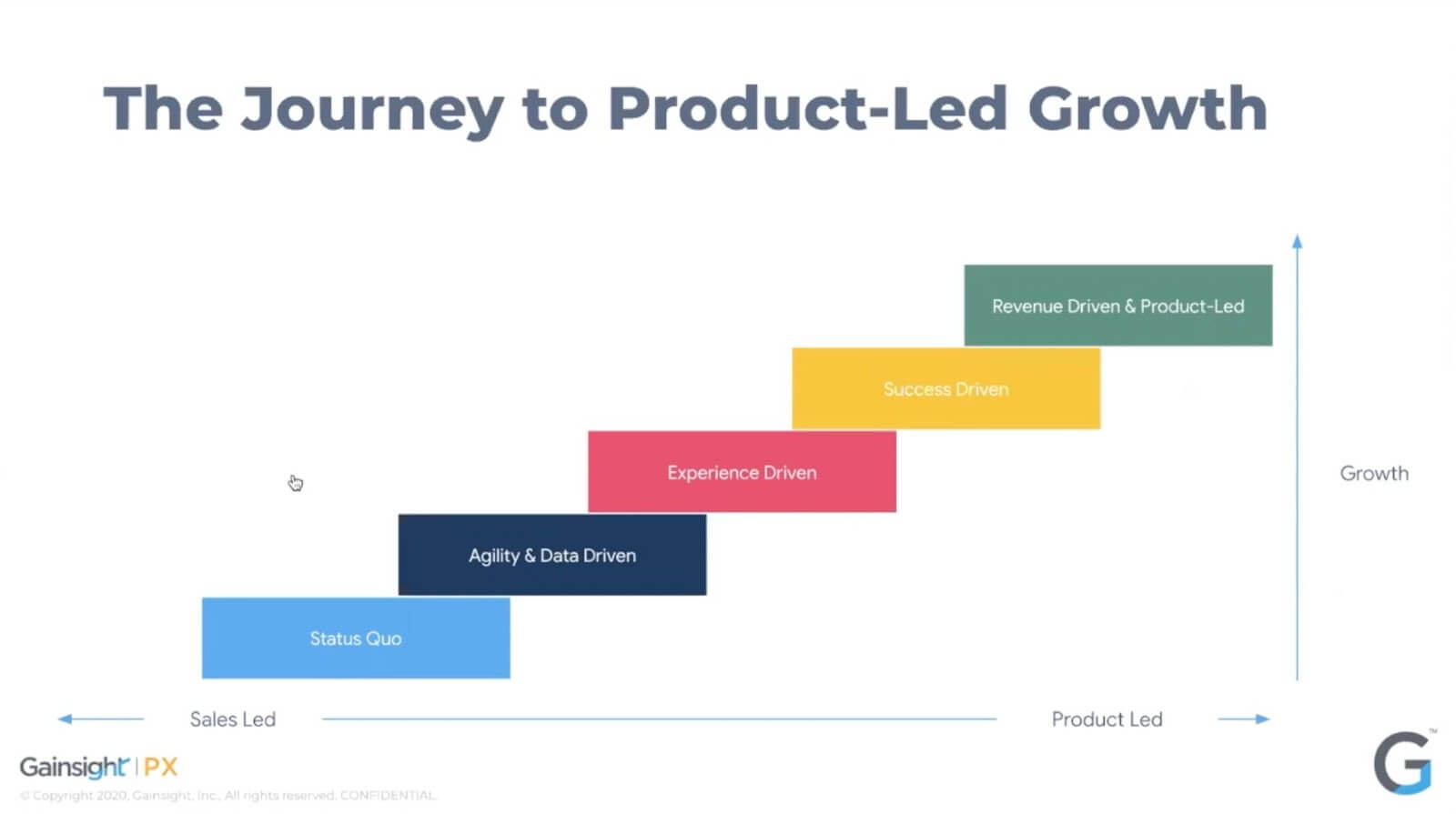
PLG and the customer lifecycle - the marketing funnel vs the flywheel
So let's talk about the shift in the customer journey, introduce the PLG flywheel, and go through a few tactics you can use to optimize your customer journey and drive growth.
Looking at traditional SaaS in the customer acquisition marketing funnel below, you can see that it’s a siloed experience that creates higher friction and a longer sales cycle. Most of the energy is spent on trying to qualify a prospect and move the pipeline forward with high-touch sales resources, where only top-qualified customers get to experience the actual product.
However, in the PLG flywheel, the funnel is turned upside down with the customer as an input rather than an output. It focuses on the end-user experience and driving growth by putting metrics, product engagement, and feedback into the customer lifecycle to deliver the optimal product experience at every stage of the customer journey.
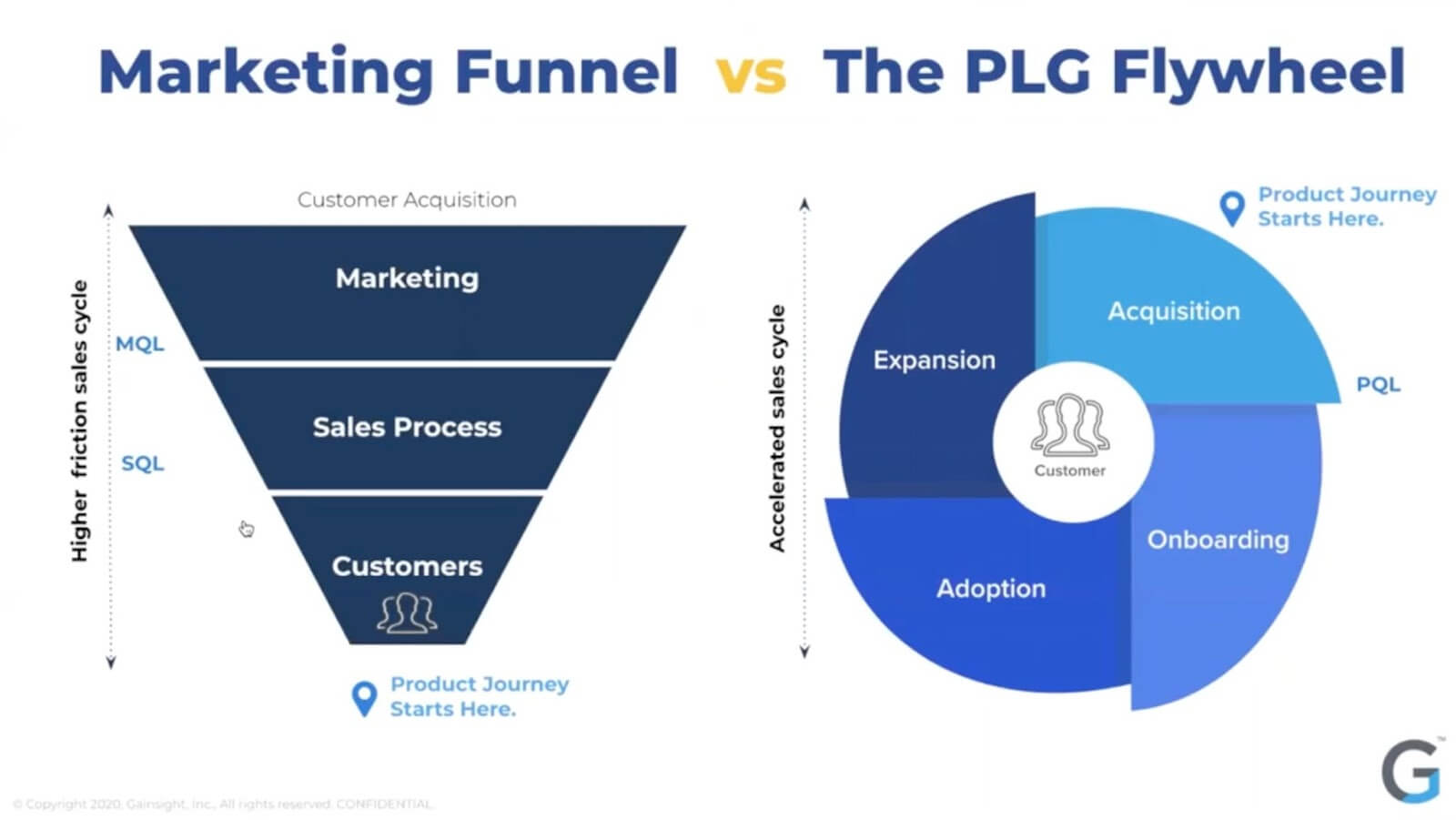
Using the PLG flywheel to drive acquisition, adoption, retention, & growth
1. Acquisition
What we teach you here is how to master the first mile of product. As you're launching your free trial, it's key to remove barriers to user sign-ups. You can use social logins and have clear pricing and packaging so your customers understand the functionality of the product you're offering as soon as they sign up.
You should avoid sign-up lead forms, and if you can you should postpone the email activation step to a later stage to allow you to start delivering value and capture that user as they sign up for your product.
In case you're serving multiple personas and objectives, it's recommended to collect data points during the sign-up and then orient your trial experience based on different user cohorts.
With Gainsight PX, as soon as you sign up we're capturing your role and objective as part of the sign-up experience so we can serve up the right onboarding experience. We also use tactics like the user onboarding checklist that helps users understand which features they need to experience to realize the initial value of the product. We’re trying to help customers help themselves with a self-provisioning motion.
When measuring different KPIs during a trial, you want to make sure that you're measuring the organic and inorganic campaigns to drive an optimized sign-up. You should also track the ‘aha’ moments you want customers to experience through the trial and see how quickly they get there. You want to measure user retention and trial conversion as well.
Understanding what drives customers in and the key value moments they experience is key, as well as trying to figure out and optimize your SEO, which is what drives them to your product.
In addition to these objectives, you want to codify the moment of values during their initial interaction with your product. Establish those key personas, the type of objectives, and how they can get there. What are the core value moments that help your customer realize the initial value of your product?
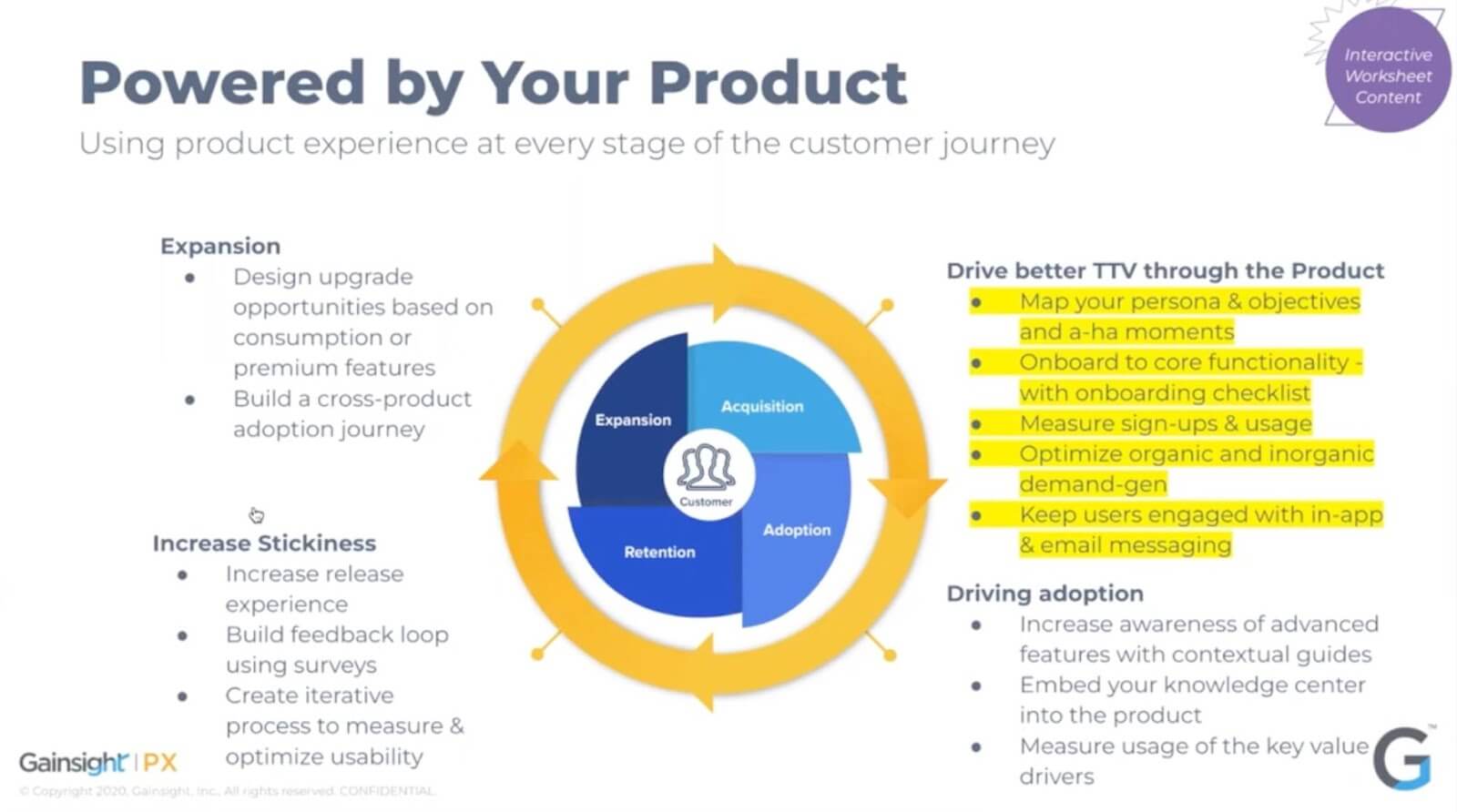
2. Adoption
We now move from the initial value in acquisition to driving the core value of your product.
Measuring adoption requires tracking metrics week over week such as user retention. It's a great way to measure stickiness. It's important that users are coming back, and you want to see that most, or at least more than 30%, return week over week to your product.
It’s also important to learn which features drive the strongest retention. You can change the cohort from sign-up week over week to the first time they actually used one of your core features to validate your hypothesis. Once they use this feature, do they come back more often or are more coming back?
So this is a very basic way to measure the stickiness of your product and measure your core features to identify which one is driving the best retention for your users.
Going beyond frequency and recency of usage, it’s recommended to track your core features and understand the breadth and depth of adoption. And to do so you want to choose those golden features that drive actual outcomes to your users.
In the below chart are the key features or value drivers of your product, and the value actions they perform in your product. You want to track them as part of the health of your product adoption.
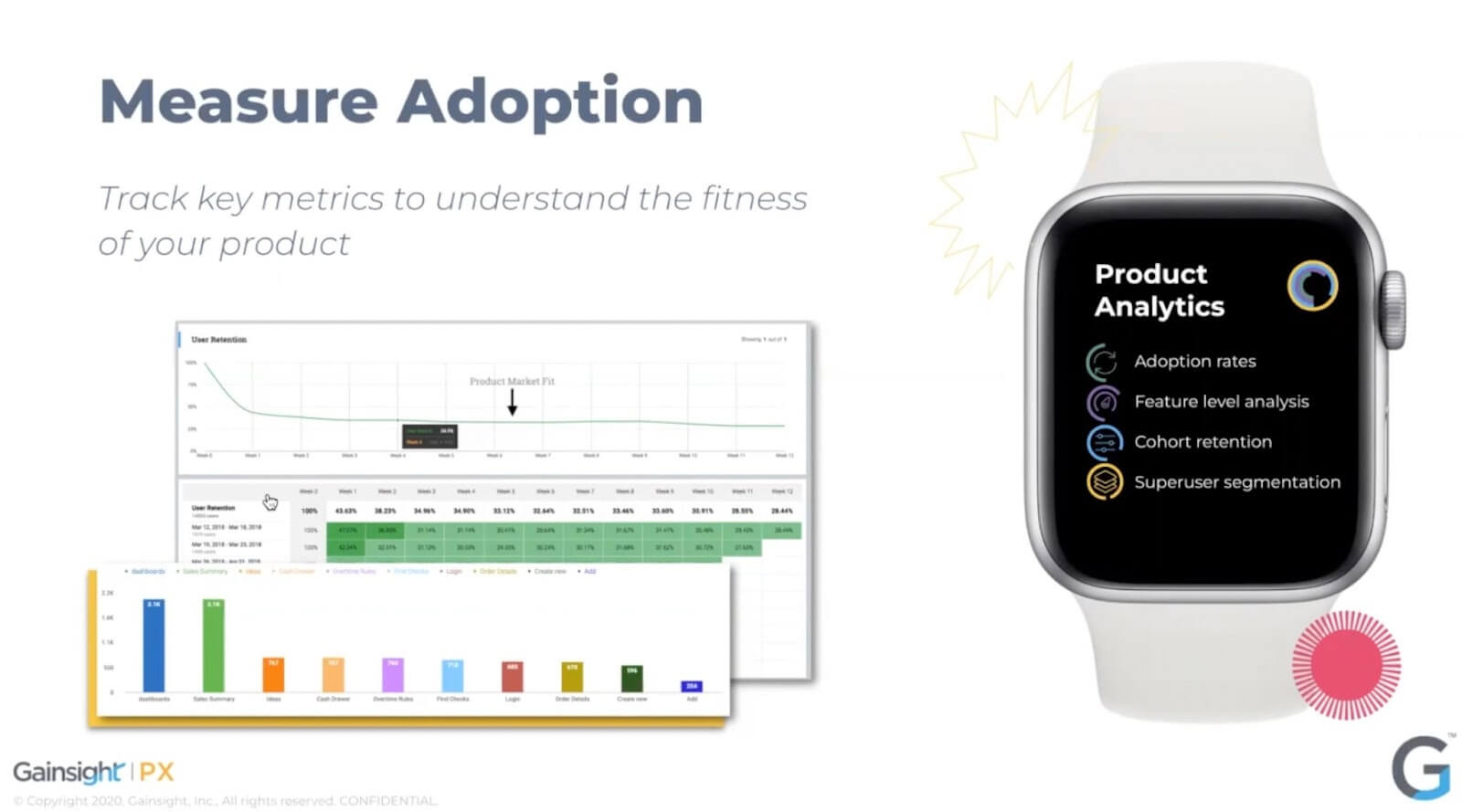
Another tactic is using contextual messaging as a nurturing strategy and driving adoption in a scalable and data-driven way. So you can use in-app guides to increase awareness of advanced features for the right user core at the right time.
If you look at the customer journey, for example, acquisition, I might trigger those first-time users. But if it's in the adoption stage, I want to trigger that based on both the right set of personas and the right adoption they view. So I'm going to use behavioral data to trigger those in-app experiences and I want to ensure that I increase feature discoverability and nurture those users to those advanced features over time.
Eventually, it's about helping your customers reach mastery level with your product. This requires you to think about that journey, message, and show them at the right moment what should they learn next, and the next best action they should learn in order to optimize and maximize the value of your product.
The next step is about orchestrating the optimal outcomes. A good outcome-driven roadmap contains a set of features that are designed to accelerate time to value. By productizing those templates or workflows, you can help customers be more successful.
The goal is to help customers with the setup. If they have an objective and you have different use cases you're serving, you can actually build those templates and specific workflows to set your customers on a success path by automatically configuring the system for their use case.
You can also use funnels to measure the time to value and completion of these workflows within a defined timeframe. A funnel is a classic way to measure how many customers there are and how much time it takes them to reach point A to point Z in that journey toward outcomes.
Next is scaling support and education. You want to promote educational videos and one-to-many office-hours sessions, allowing your customers to interact with your support and customer success teams, and helping them help themselves.
When creating an adoption strategy, you want to map the more advanced features you'd like to measure and drive adoption towards. As well as core roadmap items for a set of templates or workflows, you should consider building in your product roadmap.
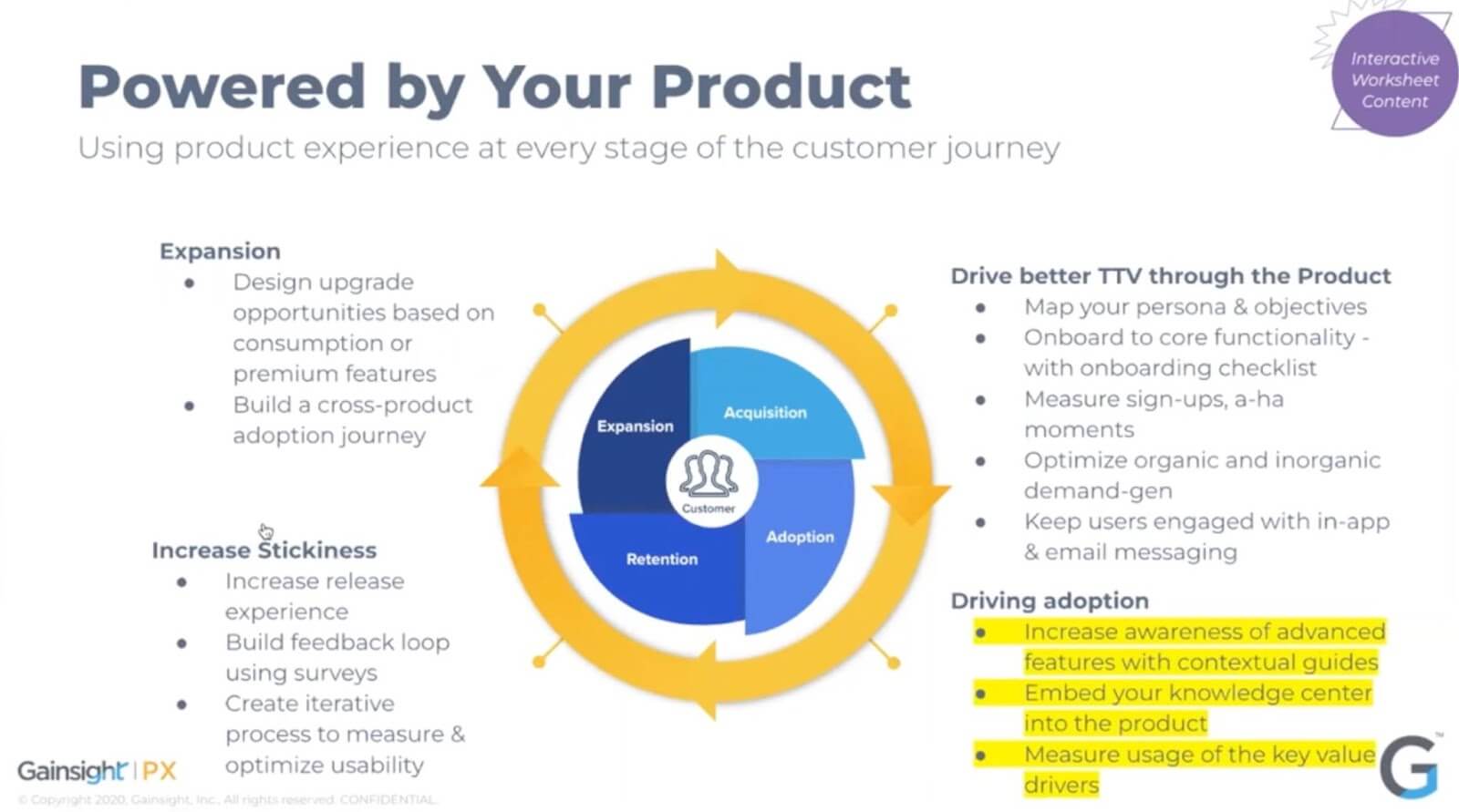
3. Retention
Here, we want to drive end-to-end value realization, so let's talk about that and how you can get there using a few tactics.
If you think about product prioritization, for example, creating an iterative process is a great way to build, measure, and prioritize feature enhancements and decide which features require increased awareness and usability improvements.
You need to map those features and prioritize the ones that need your attention. Sometimes it's just awareness and discoverability of the feature. Once they use it, it's great and leads to stickiness, but many customers aren’t aware of certain features.
With features they are aware of, they struggle to use them or they lack functionality. So you want to prioritize some improvements and improve cycles to that feature. Always be monitoring and learning about those data points and see where customers struggle, and then optimize that feature in your next release.
By having a dedicated bucket in your roadmap for these learnings, you can optimize existing features and drive customer delight.
One of the key tactics for retention is feature activation. As you can see in the graph below, for customers to realize the true value of your product, renew, and therefore drive the growth, revenue, and retention to GRR, they need to use those high-value features.
The feature activation tactic allows customers to learn about new advanced features that drive these outcomes and move them from basic users to high-adoption users with more sophisticated capabilities, to optimize and maximize the value of your product.
Map that gap between basic and more advanced usage of your product with what customers need to know, learn, and use to get there. Additionally, you want to map and promote those features with in-app walkthroughs, videos, and articles to drive customers there.
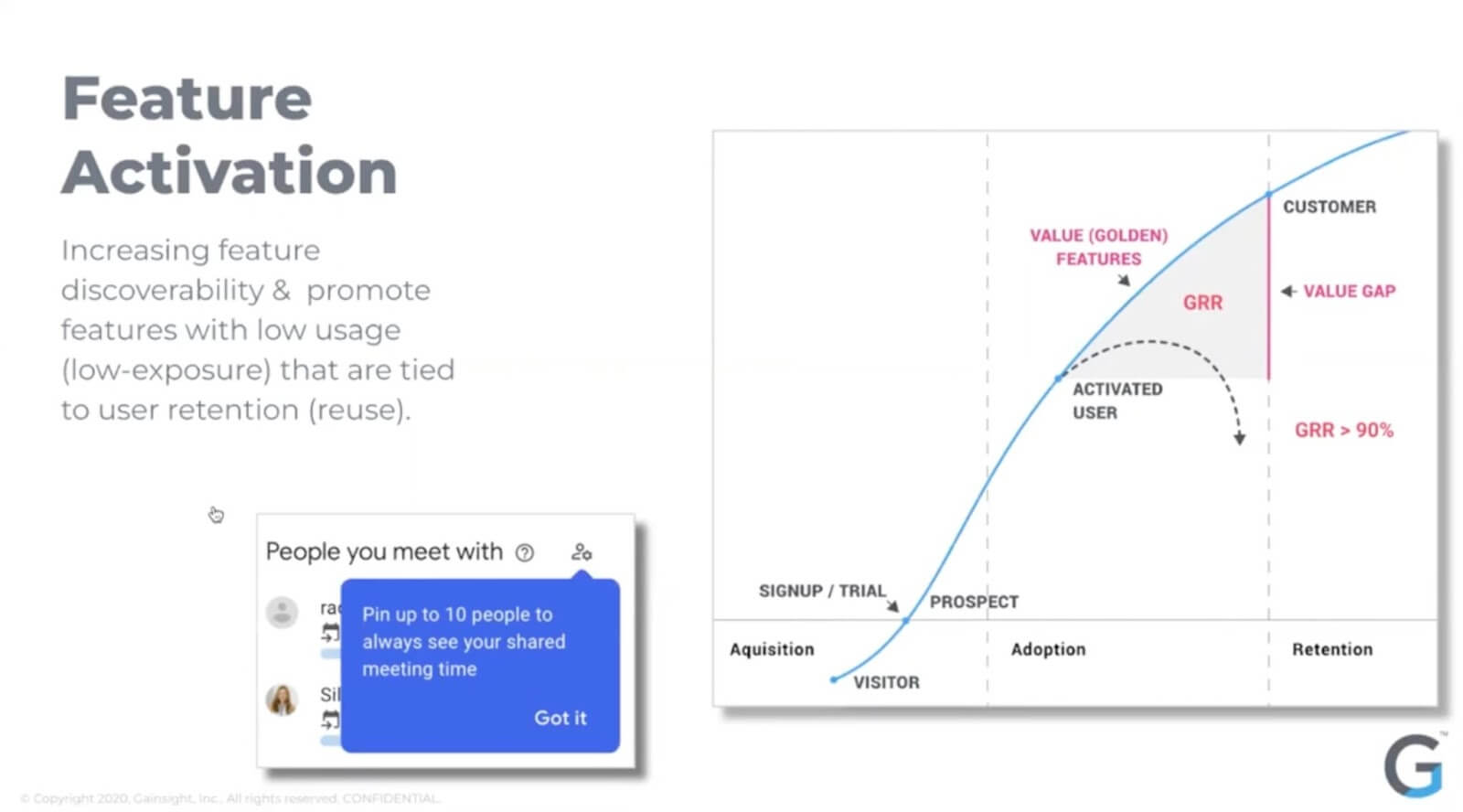
Another element that helps improve retention is tapping into user feedback. As you're driving product adoption, it's key to measure how users feel about specific features as soon as they use them. It's going beyond NPS to something more actionable and very specific.
One way to do it is through a customer effort score. it's about asking customers, as soon as they use the feature, to rate how easy it was for them to use. You can also end the survey with open-text questions or multiple-choice options to better understand what drives their satisfaction and how you can improve that experience with a very high response rate when leveraging this contextual survey.
When you capture the sentiment, you want to make sure you incorporate it into your roadmap. A great way to show customers that you're closing the loop based on their feedback is to message that release and make sure you have that bucket of resources allocated to address that set of feature requirements or improvements your customer suggested. And that will close the loop with them.
Message customers to let them know what's coming and what the feedback was, and make sure that once you release, you score again and measure the trend of that specific set of surveys correlated with the core functionality and features.
Another aspect is operationalizing subscription retention, which requires your success team to gain visibility into the breadth and depth of the product adoption. They need to identify customers at risk, and therefore build a score based on who the customer is, what stage of the journey they’re at, and how they’re doing from an adoption perspective.
These actionable insights should drive your success program and surface common areas of complexity to the product team.
Rather than just triggering the right calls to action and the type of success plays your customer should experience, you should surface an aggregated view for your product leadership and say, “We're seeing a lot of smoke in this area which actually drives advocacy. Let's make sure that the roadmap has that feedback incorporated as we’re releasing the new functionality or strategy down the road.”
Another tactic is continuously surfacing outcomes to users. We tend to try and summarize everything before the customer renews or once a quarter. But one great and scalable way to do it is to continuously surface outcomes and opportunities for your customers to improve using personalized outreach outside the product.
Based on where they are and what they've done, you can message them continuously so they build up that value realization of your product, as opposed to trying to squeeze everything in those quarterly discussions or just before the renewal.
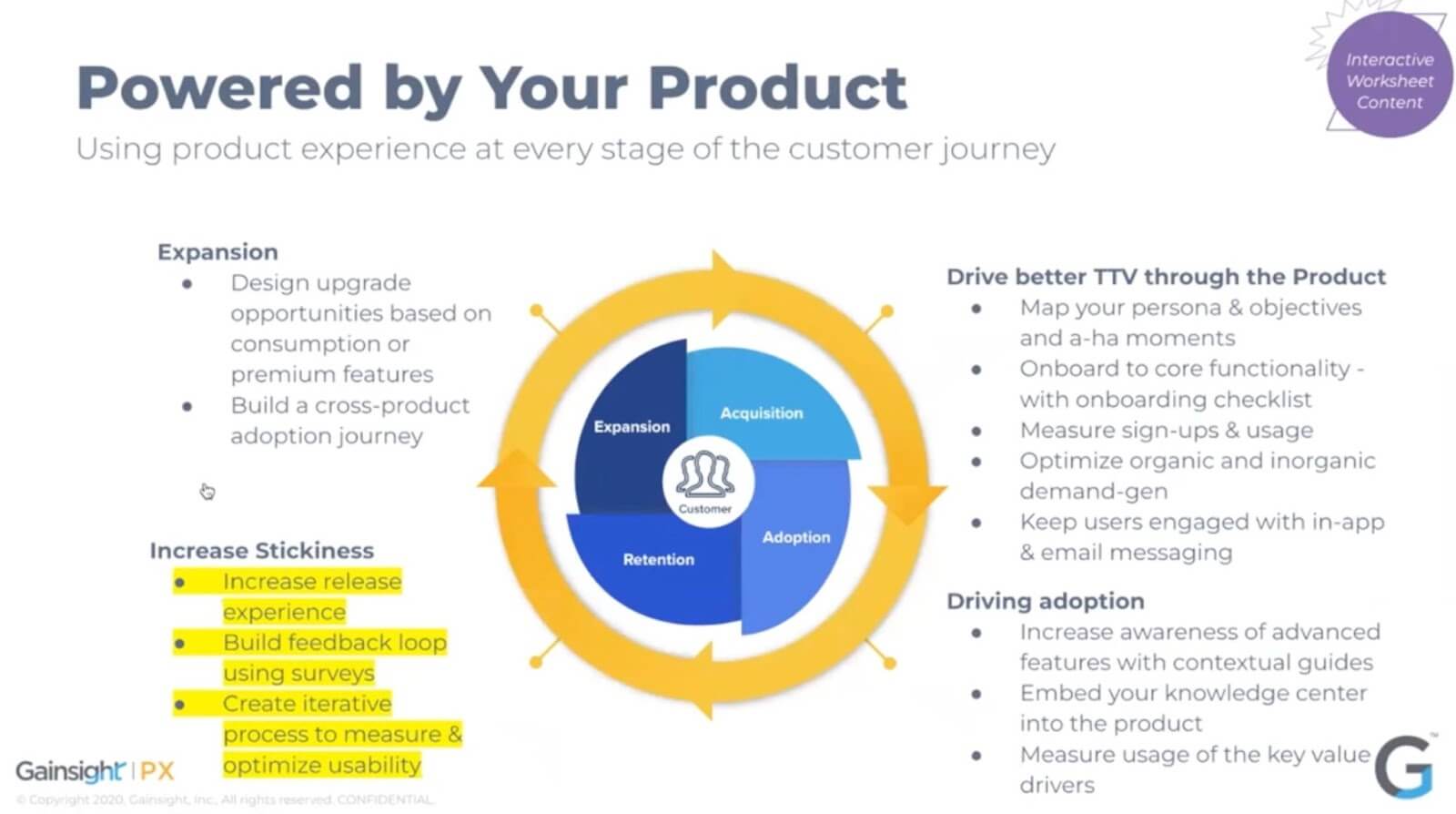
4. Expansion
In the expansion stage, we learn how you can increase the number of seats, premium features, or consumption that drives your NRR. These are usually the levers in each product.
Firstly, you want to make sure that you're optimizing your pricing and packaging to align with increased value and usage, which is foundational to driving successful growth.
For example, with social solutions, map those product packages and functionality to make sure they can build the right experience and set of features to the right stage of the customer journey. As you mature, you’re exposed to more functionality, and your license goes up. So it's a combination of premium features, usage, and seed base that drives that growth.
So as you're acquiring more customers, one of the key growth levers is selling more product to your install base in order to drive that expansion.
Designing data-driven, cross-sell, and up-sell motion targeting to your install base is the most effective way to create durable growth, and offering the next package should be natural. So when you think about product roadmap strategy and pricing and packaging, you should see the alignment because eventually, the best and optimal way is to sell the right package to the right person at the right time.
Ensure alignment
Make sure that that alignment exists because it's pretty foundational, and without it, optimizing your expansion is going to be more difficult.
In most SaaS products, investing in native integration helps you drive growth. With native integrations, you can increase the ROI by making sure that your products seamlessly integrate with customers’ internal systems.
You want to be able to ingest relevant data, enrich your data, and potentially open your product to orchestrating goals within a company. Once you introduce your solution to a company, you want to make sure that it’s seamlessly integrated into the company’s CRM, messaging system, or orchestration engine so your product is playing a key role in delivering value for them.
You also want to make sure that your product exposes and exports data to the ecosystem so you can become the system of record to the problem that your solution’s solving.
It's a bi-directional thing. First, you want to ingest data to ensure you can surface the data that's relevant to your solution. This will drive value, but also export data back to the system so the enriched data your product’s creating is going back to the system of the company, allowing them to increase the value. And make sure they have consistent datasets across their system to make your product much stickier.
Facilitate organic expansion
The last tactic is facilitating organic expansion. Organic expansion is a powerful tool to drive expansion to other teams in the business unit within the organization.
You want to reduce friction in provisioning, so allowing your customers to sign up is a great product-led tactic in order to facilitate that organic expansion.
You need to make it easy to invite other users or provision a new instance of your product, or a workspace or project you can share with other business units.
You want to be able to trigger notifications or create collaboration around features, but empowering and facilitating organic expansion through features is one tactic. You can see how monday.com for example always nurtures customers to collaborate and invite other users in order to drive expansion.
As the last step, map the value drivers you should optimize towards increasing revenue. You want to make sure that first, your pricing and packaging are aligned, but make sure that you have those design experiences lined up for cross-sell and up-sell motion, and see that you have that alignment between pricing and packaging, and potentially what's missing in your product to get there.
Design the average opportunities based on that consumption. If your pricing is based on monthly active users, the number of projects, or number of campaigns, make sure that you’ve designed this around functionality you can deliver to drive the usage of this feature. This potentially is your north star metric; that set of features are delivering the most outcome for your customers.
So you want to make sure that you design those upgrade motions or you’re driving adoption of these features because that's exactly what drives the growth of your product.
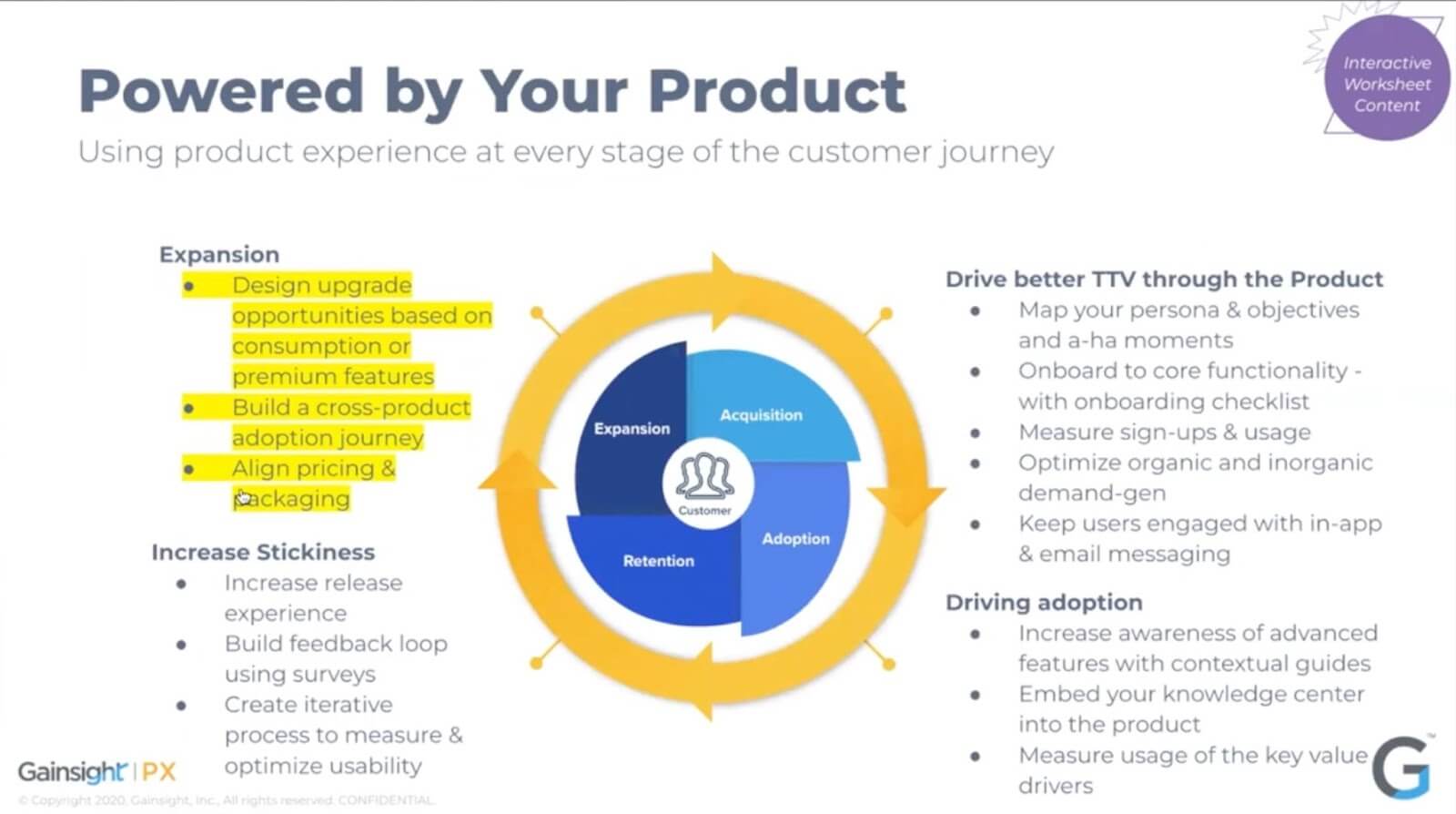
Key takeaways
PLG will continue to disrupt the market as it comes with a superior unit of economics. It doesn’t eliminate the need for marketing, sales success, and support; you just orchestrate these teams across the customer journey and introduce them at the right moment in a scalable way, and make sure that they have enough data or the right data set to drive their action.
PLG also requires deep visibility of product usage data and user feedback. So you can optimize these experiences and continuously learn and optimize your product experience towards adoption.
You should start with retention before acquisition. It's easier to maximize revenue impact by focusing on retention and seeing and mapping those core features, making sure you're driving that adoption before you move towards trial experience, freemium, or any changes to pricing and packaging.
The last thing is aligning the roadmap strategy with that go-to-market strategy. If you see social solutions building those right packages for the right type of customers and stage, and unlocking features as customers require more advanced features, that drives more consumption and value for your customer.
In a nutshell, that's how to leverage PLG as your product strategy and address each stage of the customer lifecycle. What do they need to be successful? Using data, identify what the friction points are, and how you can optimize that.
Always apply closed-loop feedback and processes to make sure that all those insights and data-driven decisions are being applied and that you're closing the loop with your customers toward successful growth.
Thank you.



 Follow us on LinkedIn
Follow us on LinkedIn



